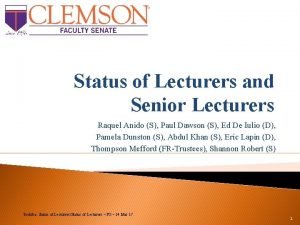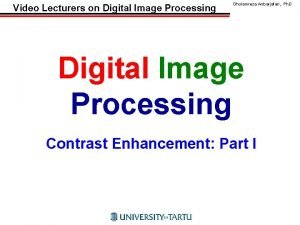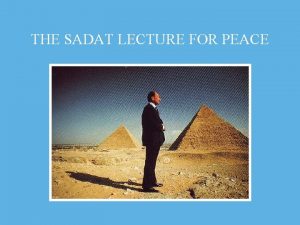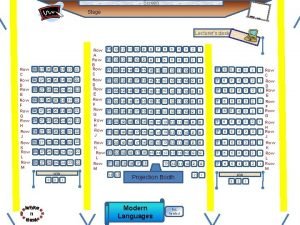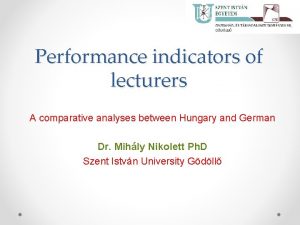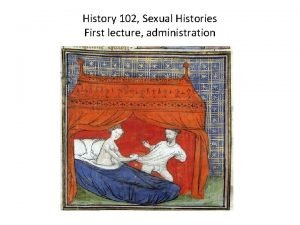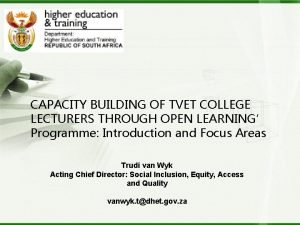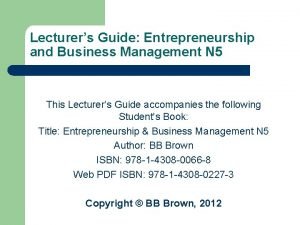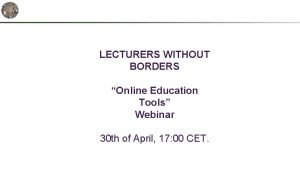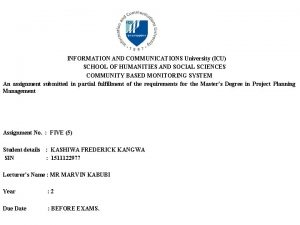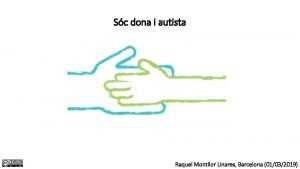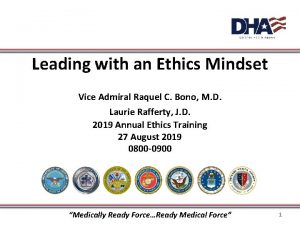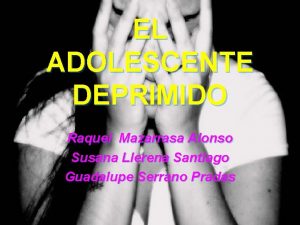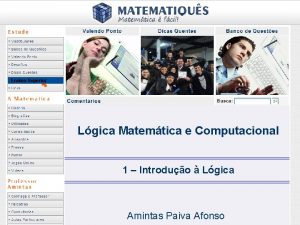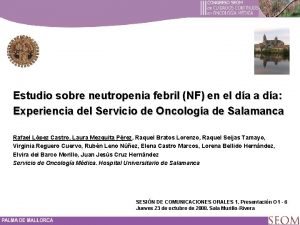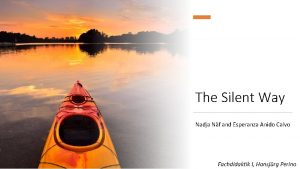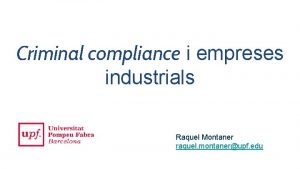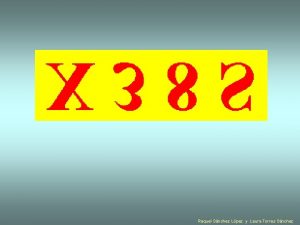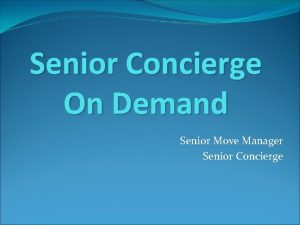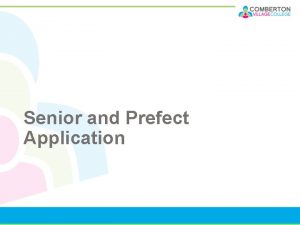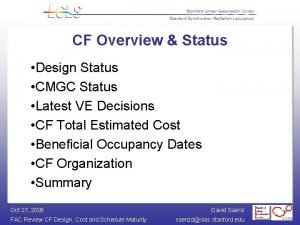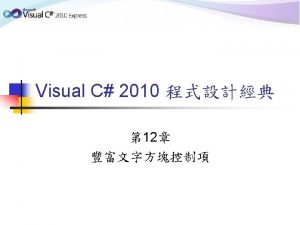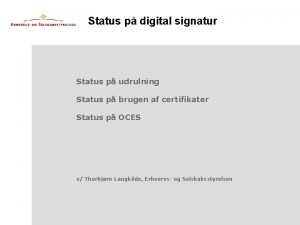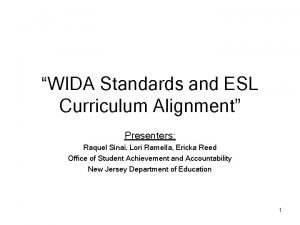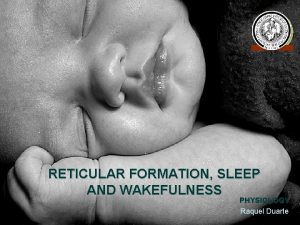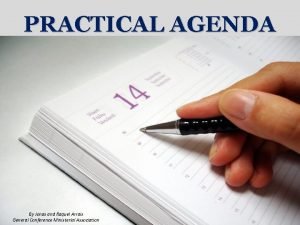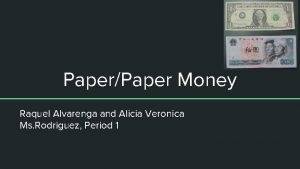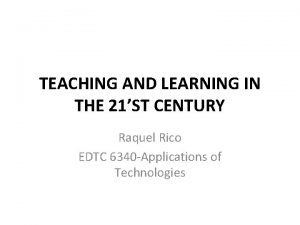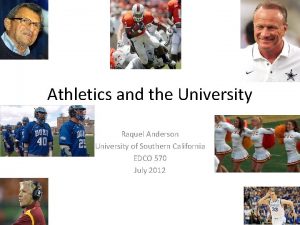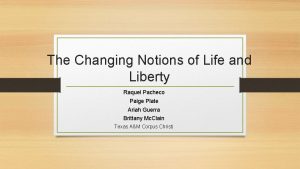Status of Lecturers and Senior Lecturers Raquel Anido






















- Slides: 22

Status of Lecturers and Senior Lecturers Raquel Anido (S), Paul Dawson (S), Ed De Iulio (D), Pamela Dunston (S), Abdul Khan (S), Eric Lapin (D), Thompson Mefford (FR-Trustees), Shannon Robert (S) Toshiba: Status of Lecturers/Status of Lecturers – FS – 14 Mar 17 1

Purpose This report is respectfully submitted to satisfy Faculty Senate’s charge to the ad hoc Committee on the Status of Lecturers and Senior Lecturers issued on 17 Feb 2016. 2

Overview Committee Charge Approach Survey Results AAUP Recommendations Committee Recommendations Barriers to Recommendations 3

Committee Charge Investigate status of lecturers, senior lecturers, and similar ranks at peer institutions Peer institutions approved by EAC Elements to investigate: • Participation in Faculty Senate and similar bodies • Participation in college and university-level curriculum committees • Policies and procedures for appointment, reappointment, and promotion at department, college, and university levels Develop recommendations based on findings Identify barriers to achieving recommendations 4

Approach Proposed list of institutions to EAC approved list of institutions - R 1 No Med Schools Committee developed list of questions Committee members contacted institutions for answers • Attempted to contact university officials • Where possible, when institutions did not reply, committee members searched institution web site for answers (Faculty Manuals, curriculum committee information, etc. ) 5

Peer Institutions Surveyed Arizona State Purdue U of Central Florida Colorado State Texas A&M U of Delaware Georgia Tech U of Albany, SUNY U of TX, Austin Iowa State U of AL, Huntsville Washington State Montana State U of CA, Santa Barbara North Dakota State U of CA, Santa Cruz 6

Rank and Structure Ranks • Survey – Half have 2 levels and half have 3 or 4 levels • Clemson – two level system Promotion Interval • Survey – Mostly 4 to 6 years between promotion eligibility • Clemson – 4 years Who does evaluations: • • Appointment – Search committee Reappointment – Mostly the department chair Promotion – Equally divided between the chair and committees Clemson – Committees for all three evaluations 7

Rank and Structure Lecturer participation in appointment, re-appointment and promotion • Survey – mostly “No” for all three levels • Clemson – appointment – mostly “Yes” • Clemson – re-appointment and promotion - split Criteria for promotion • Survey – Includes combinations of teaching excellence, student evaluations, service, academic advising, and in one instance includes grant writing, scholarly activities, and peer evaluations • Clemson – Primarily teaching, departments may or may not include service 8

Rank and Structure Specified salary increase with promotion • Survey – 8 institutions – “No” 3 institutions – “Yes” 5 institutions – no information • Clemson – varies, no stated rule 9

Faculty Governance Faculty Senate Participation and Voting • Survey: 8 – “Yes”, with voting privileges 6 – “No” • Clemson: “Yes” without voting privileges Restrictions in Faculty Senate Work • 4 of 8 institutions had no restrictions • Of the four institutions with restrictions, memberships is limited to some committees • Clemson – participates in committees but cannot vote 10

Curriculum Voting in University Curriculum Committee • Survey – split between institutions • Clemson – “No” Voting in College Curriculum Committee • Survey – split between institutions • Clemson – “No” Proposing new courses and programs • Survey – split between institutions Primary take away – while NTT could champion proposals, TT would carry them forward • Clemson – varies at department level 11

AAUP Recommendations “Faculty members who hold contingent appointments should be afforded responsibilities and opportunities in governance similar to those of tenured and tenured track colleagues. ” “All members of the faculty should be eligible to vote in all elections for college and university governance bodies on the basis of one person, one vote. ” https: //www. aaup. org/news/new-report-contingent-faculty-and-governance#. WDNDn. MEz. WUk Jan 2013 12

AAUP Recommendations “While faculty in contingent appointments may be restricted from participating in the evaluation of tenured and tenured-track faculty, they should have the opportunity to contribute to the evaluation of contingent faculty. ” “Faculty holding contingent appointments should be compensated in a way that takes into consideration the full range of their appointment responsibilities, which should include service. ” https: //www. aaup. org/news/new-report-contingent-faculty-and-governance#. WDNDn. MEz. WUk Jan 2013 13

Motivation for Change Clemson Forward • “… ensure Clemson fulfills its core mission and consistently ranks among the nation’s top 20 public institutions and Carnegie tier-one research institutions. ” • Strategic Priorities – Engagement and the Academic Core “Rank among the nation’s top-10 public universities in undergraduate student success, as measured by freshman-tosophomore retention and six-year graduation rates. ” Large proportion of first year general education courses taught by lectures and senior lecturers – can’t get to six-year grad rate without first year retention To retain students shouldn’t they have lecturers who are the best and brightest? To retain the best and brightest lecturers then … 14

Committee Recommendations 15

Committee Recommendations Rank and Structure: • Add third lecturer rank • Include mandatory, stated pay increase with promotion similar to TT faculty • Adopt Oklahoma State Faculty Salary Survey compensation levels • Include NTT faculty in appointment, re-appointment, and promotion committees for NTT faculty 16

Committee Recommendations Governance: • Provide full rights, privileges, and responsibilities for delegates in the Faculty Senate Base representation on same type of percentage model currently used for Senators Curriculum: • Allow FTNTT faculty voting membership at departmental curriculum meetings and potentially at the college and university levels 17

Barriers Rank and Structure Recommendations • Third lecturer rank Add to FM Part III, E “Special Faculty Ranks” Potential HR implications – job titles? • Pay increase with promotion Change to FM Part IV, D. 2. Salary Determination Procedures – add lecturers and senior lecturers to strengthen Funding • OSU Faculty Salary Compensation Levels Funding FM = Faculty Manual 18

Barriers Rank and Structure Recommendations (continued) • Include NTT in appointment, re-appointment, and promotion committees for NTT faculty Delete “departmental Tenure, Promotion, and (Re)appointment (TPR) committee” phrase from FM Part VII, paragraph M titled “Committees Restricted to Regular Faculty as Voting Members” 19

Barriers Governance Recommendations • Change FM Part II, F. Terminology, 2 Regular faculty Delete first sentence referring to “a subset of the faculty defined in the Constitution of the Faculty. ” Add lecturers and senior lecturers to the list of regular faculty Curriculum Recommendations • Delete “college and university curriculum committees” phrase from FM Part VII, paragraph M titled “Committees Restricted to Regular Faculty as Voting Members” 20

Global Solution Path to Accomplish Recommendations Electurers and senior lecturers to the Faculty Constitution, Article 1, Section 1 defines the Faculty • Includes this phrase in the list of individuals as members “… and such other individuals as the faculty may duly elect. ” • Election to membership “… must be submitted to the Faculty Senate and referred by that body, with its recommendation, to the faculty for action at the next regular meeting of the faculty. Election to membership shall be by simple majority vote of the members present. ” Constitution, Article 1, Section 4 states, “The quorum for any meeting of the faculty shall be that number of members deemed necessary by the chair [the Provost] to transact business other than the amendment of this constitution. ” This approach is not an amendment – faculty already has the right to elect other individuals to the Faculty 21

Questions? 22
 Aaup porta
Aaup porta Raquel anido
Raquel anido Raquel anido
Raquel anido Union vs intersection
Union vs intersection Raquel anido
Raquel anido Raquel anido
Raquel anido Raquel anido
Raquel anido Ebm n5 study guide pdf
Ebm n5 study guide pdf Lecturers without borders
Lecturers without borders List of lecturers at icu zambia
List of lecturers at icu zambia Raquel montllor linares
Raquel montllor linares Que significa raquel
Que significa raquel Raquel mendoza age
Raquel mendoza age Tulang inaawit habang may sumasayaw
Tulang inaawit habang may sumasayaw Raquel bono
Raquel bono Veonika raquel
Veonika raquel Santiago mazarrasa
Santiago mazarrasa Ufmg raquel julia rita carolina
Ufmg raquel julia rita carolina Raquel huidobro
Raquel huidobro Raquel duarte-davidson
Raquel duarte-davidson Baradad dermatologo
Baradad dermatologo Raquel montllor linares
Raquel montllor linares Raquel bratos lorenzo
Raquel bratos lorenzo
